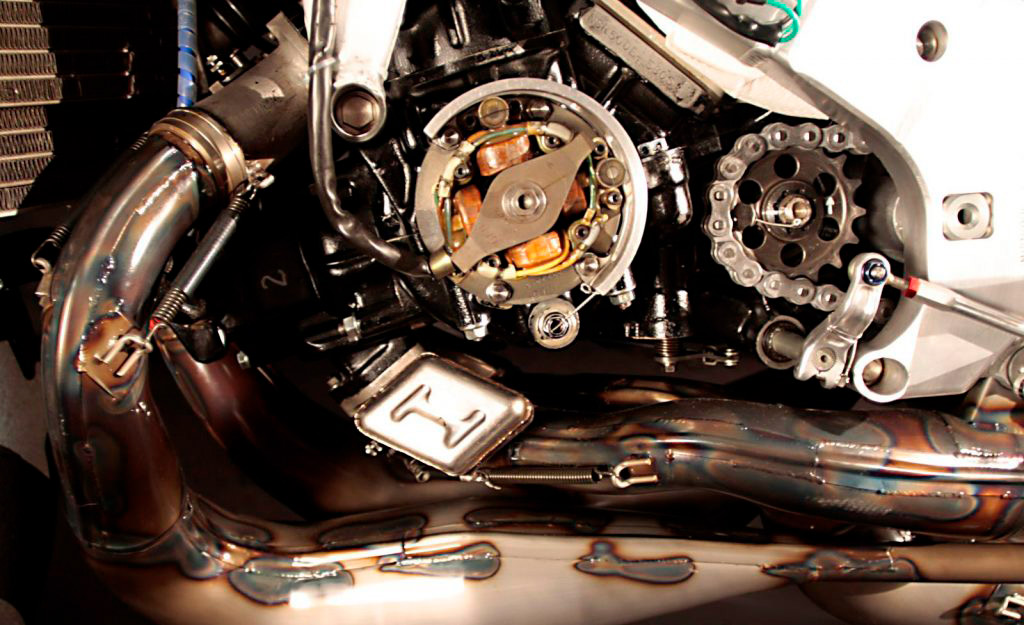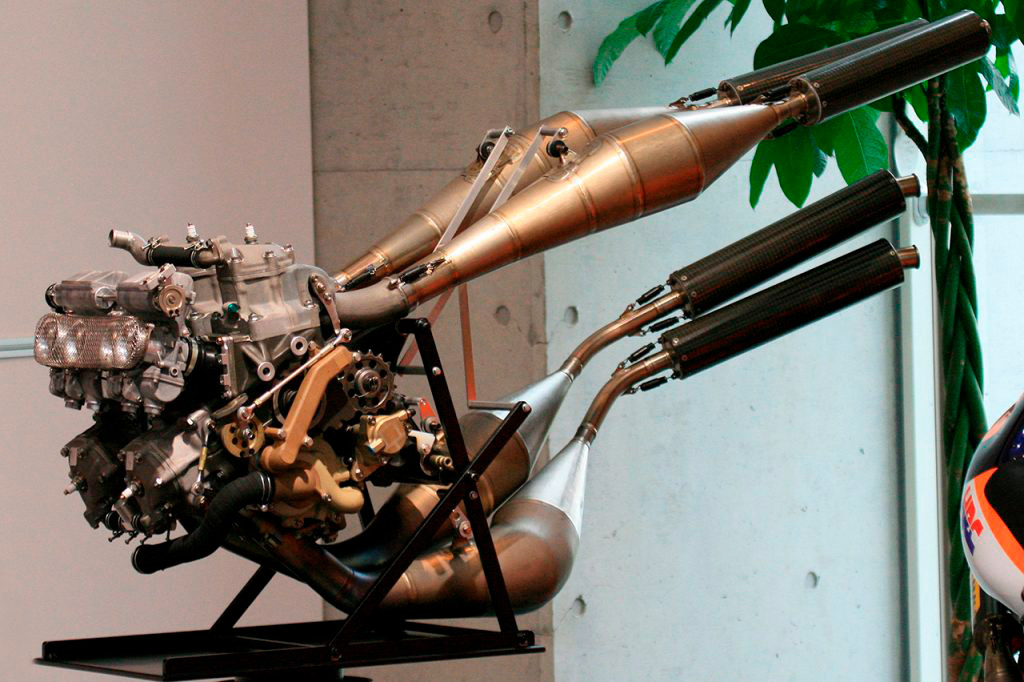Esta increíble motocicleta obtuvo más de 130 victorias, reunió a más de 10 pilotos campeones del mundo y 11 constructores.
La NS500 fue la predecesora de nuestra estrella. Una máquina con motor en forma de V y tres pistones que le dio a Freddie Spencer la victoria en el Campeonato Mundial de 1983. La fábrica japonesa, lejos de dormirse en los laureles, presentó un nuevo modelo que añadió un pistón adicional al motor en 1984. Así nació la NSR500, una moto que marcaría una época.
Sin embargo, cabe reconocer que el primer modelo presentaba una serie de características únicas que no funcionaban especialmente bien. En el diseño del chasis, los tubos de escape se ubicaban en la parte superior y el depósito debajo del motor, y presentaba una combinación entre un chasis de doble viga y uno multitubular. Además de “darle la vuelta a la moto”, Honda añadió un cuarto pistón adicional, aumentando así la potencia del motor. Para aprovechar al máximo el aumento de potencia del motor, se equipó con un solo cigüeñal en lugar de dos contrarrotantes, lo que minimizaba las pérdidas por fricción. Finalmente, se incorporó un sistema de entrada de válvulas de láminas que sustituyó a las válvulas rotativas utilizadas hasta entonces.


| Motor NSR 500 1984 y 1985 | |
| Desplazamiento | 499 cc |
| Tipo de motor | V4 de 2 tiempos a 90° |
| Fuerza | 140 CV a 11.500 rpm |
En 1985, Freddy Spencer obtuvo su victoria en el Campeonato Mundial con una Honda gracias a los avances en la NSR500. El chasis original presentado el año anterior se descartó en favor de un diseño más estándar, con vigas dobles y los tubos de escape y el depósito en su lugar habitual. El equipo mejoró el rendimiento del motor incorporando un innovador sistema ATAC (Cámara de Amplificación de Par Autocontrolada), un sistema de válvulas en el sistema de escape que optimiza el flujo de gases.
In the following years, progress continued to be made. In 1987, the bike underwent a significant remodelling in which the V-angle between pistons was raised to 112°, which left enough space for four 36 mm Keihin carburettors in the centre of the V. This modification led to improved air intake, which in turn increased its performance. Another important adjustment made was the direction in which the crankshafts rotated to counteract the gyroscopic effects of the wheels, improving the bike-s performance in run-off areas. Even though the bike’s manoeuvrability improved, it did create the need to add an additional shaft to invert the spin direction at the engine’s exit, which slightly decreased its power.
This bike handed Wayne Gardner the first position that year, so it was safe to assume the changes made were headed in the right direction.


| NSR 5000 engine 1987 | |
| Displacement | 499cc |
| Engine type | 2-stroke V4 at 112° |
| Power | 156 hp at 13 000 rpm |
In the year 1989, the Honda NSR500 was the pinnacle of acceleration. Thanks to its reinforced chassis and a special swingarm that accommodated the expansion chambers in the exhausts, the boost in performance was so great that no other motorcycle could match its acceleration rate or velocity. However, the frame was unstable and difficult to control. On the tracks, this beast could surpass speeds of 310 km/h, and the engineers increasingly turned their attention to ways in which the bike could be made more manageable without compromising its power. With its sheer force, this bike managed to place Eddie Lawson at the top of the competition in 1989.
| NSR 5000 engine 1989 | |
| Displacement | 499cc |
| Engine type | 2-stroke V4 at 112° |
| Power | 165 hp at 13 000 rpm |
One of the most drastic changes an engine can undergo is a change in the ignition timing, so the pistons can deliver the power all at once or in a distributed manner. In 1990, Honda decided to take a step in this direction and created an engine that fitted the pistons in sets of two at 180° angles. This engine, also known as the ‘Screamer’ because of the sound it makes, delivered continuous power making the machine even more difficult to control, if possible. As a trade-off, the bike’s performance peaked. The main challenge now was finding a rider capable of taming it, but luckily Honda had an Ace up its sleeve that went by the name of Mick Doohan. The Australian rider snagged the third position in the 1990 World Championship with the NSR500, a bike he would become inseparable from in the coming years.


| NSR 5000 engine 1990 | |
| Displacement | 499cc |
| Engine type | 2-stroke V4 at 112° |
| Power | 170 hp at 13 000 rpm |
When changes in regulation increased the minimum weight to 130 kg and set limits for the breadth of wheels, it became necessary to make further adjustments to soften the NSR500’s temper. Its powerful engine meant that, in its new design, the bike would swerve when giving it the littlest bit of gas. It was the fastest frame on the grid in terms of peak speed, but it had a harder time accelerating and could not run the curves as smoothly. However, even this could not stop Doohan from coming in second at the 1991 World Championship.
However, the Honda team decided to make it easier to handle, and the engine’s configuration once again underwent a drastic change in 1992. The ignition timing was changed yet again, so that all pistons fired practically simultaneously. This new system, known as ‘Big Bang’, provides the engine with increased resting time between each firing, and gives better traction and less wear to the tyres with only a slight decrease in power. With this new configuration and given the 112° angle of the bank of cylinders, the vibrations generated by the simultaneous firing were counteracted, and one of the rotating shafts could be removed since its only purpose was to soften said vibrations.
In 1993, an important technological breakthrough took place when electronic fuel injection was implemented. With two injectors per piston and an ECU which was capable of managing the supply’s optimum functioning. This system made it possible for Sinichi Itoh to become the first pilot that achieved speeds of over 320 km/h. In spite of this success, there did not seem to be significant improvements in comparison to traditional carburettors, so the entire system was dismissed.
| NSR 5000 engine 1993 | |
| Displacement | 499cc |
| Engine type | 2-stroke V4 at 112° |
| Power | 170 hp at 12 500 rpm |
Even though the 1994 season saw no major changes, towards the end a water injection system was incorporated to the exhausts which improved performance in the mid-range of revolutions. An extra 10 hp were achieved in the range between 6000 and 10 000 rpm when the temperature of the combustion chambers was modified. Doohan decided against this improvement and instead chose a more conventional engine, since the bike was already sufficiently hard to handle. Doohan finally managed to win the World Championship on this machine, making it evident that the NSR500 development was reaching its peak.
In 1995, carburettors over 39 mm were installed, significantly improving performance. Thanks to this tweak, and a stronger than ever Honda team, Doohan won his first two World Championships for the Repsol Honda Team in 1995 and 1996.
| NSR 5000 engine 1996 | |
| Displacement | 499cc |
| Engine type | 2-stroke V4 at 112° |
| Power | 190 hp at 12 000 rpm |
The Screamer engine made its way back to Doohan’s bike in 1997. The Australian rider preferred the engine’s more aggressive behaviour despite the handling difficulties it posed. The power delivery was increased. Another important improvement were the changes made to the gears, which now made it possible to shift to a higher gear without letting go of the accelerator. This fierce engine gave Doohan another world championship title.


| NSR 5000 engine 1997 | |
| Displacement | 499cc |
| Engine type | 2-stroke V4 at 112° |
| Power | 200 hp at 12 000 rpm |
Once again, changes in regulations made drastic changes to the Engine necessary. The use of unleaded petrol was imposed, and all motorcycles were forced to switch to the Screamer engine to make up for the power loss associated with this change. However this did not bar the NSR500 from living a golden period and grant another 3 world championships to its jockeys. Doohan in ‘98, Alex Crivillé in ‘99, and Valentino Rossi in the year 2001.
| Motor de la NSR500 de 2001 | |
| Displacement | 499cc |
| Engine type | 2-stroke V4 at 112° |
| Power | 185 hp at 12 500 rpm |
2002 was the last year for the NSR500, although this model did not see its end just yet. The sun had set on two-stroke engines. This incredible motorcycle obtained over 130 victories, collected more than 10 world championship riders, and 11 constructors. The NSR500 was eventually replaced by the RC211V, but this does not mean it’s the end of the road… it is barely the start!

MotoGP
The Honda RC211V The dawn of a new era
3 months ago

MotoGP
Evolution of the Repsol Honda engine: the RC212V and the RC213V
3 months ago


 Join Us
Join Us  Join Us
Join Us 